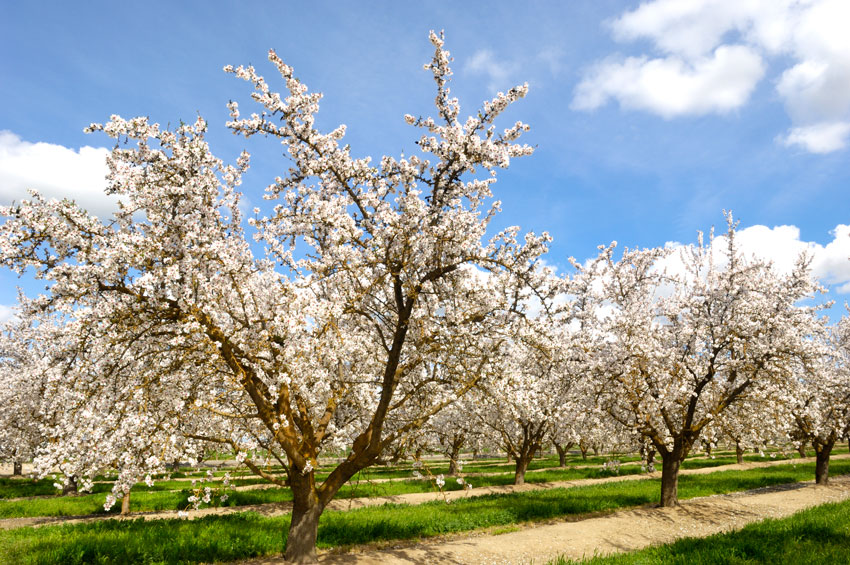California Almonds Bloom After Going ‘Nuts’ Due to Drought
Close-up of ripening immature almond (Prunus dulcis) fruit growing in clusters in the San Joaquin Valley, Calif.
California almonds, which cater to about 80 percent of the global demand, have fully recovered from a four-year drought that ended in 2016, with the harvest returning to record levels this year, according to growers and promoters of the resilient crop, writes Shakoor Rather.
Almonds are becoming more important to California and to consumers worldwide, who are eating more of the tree nut per capita than ever, amidst criticism for the crop’s extensive water usage.
Fuelling the boom is robust foreign demand, particularly from markets like India and China, where the industry has been promoting almonds as a healthful snack.
The state harvested an estimated 1.85 billion pounds of shelled almonds in 2013-14, which was slightly less than the 1.88 billion pounds in 2012-13, according to the Almond Board of California (ABC).
However, after dropping during the drought, the 2017 almond crop rebounded to a record 2.14 billion pounds of shelled nuts, the board said.
“California almond orchards spread over 1.33 million acres in 2017, spanning 500 miles. 2018 forecast for almond production is 2.45 billion pounds, on 1.07 million bearing acres,” said Richard Waycot, President and CEO, ABC.
“The world tree nut production is 4,187,108 metric tonnes and almonds form about 30 per cent of the total nut production followed by walnuts at over 20 per cent,” he said.
With 6,800 growers and 101 processors, the board said, almonds form California’s top valued agricultural export and number one US specialty crop export.

California’s Central Valley has mild winters and abundant sunshine which makes it the perfect place to grow almonds.
Harvest begins in August and ends in mid-October before winter rains begin. Almond varieties are harvested separately, meaning the harvest process occurs 2-3 times.
Winter rains in the valley and snow-melt from the surrounding mountains replenish the groundwater annually to some extent, but drought has parched the valley since 2011.
There is a robust system in place where growers can bring water from mountains full of snow, said Danielle Veenstra, Manager, Reputation Management & Sustainability Communications at ABC.
Almond-picking is also a highly mechanised process, which attracts farmers concerned about migrant-worker labour shortages, and its long history in the state creates a level of expertise competitors can not match.
Veenstra said that over the past 20 years, almond farmers have improved their water use efficiency by 33 percent, producing more crop per drop.
She said 87 percent of farmers practice demand-based irrigation instead of using a fixed schedule.
Almond farmers, said Veenstra, use efficient micro-sprinkler or drip irrigation at nearly two times the rate of farmers state-wide.
“To help sustain groundwater levels, almond farmers and researchers are experimenting with flooding orchards in the winter to recharge underground aquifers,” she said.
Before the drought, the big concern for almonds was the supply of pollinators.
Honeybees began dying in alarming numbers in 2006 due to a phenomenon named Colony Collapse Disorder. Millions of bees mysteriously disappeared, leaving farms with fewer pollinators for crops.
Explanations for the phenomenon have included exposure to pesticides or antibiotics, habitat loss and bacterial infections.
Beehives are now more expensive as permanently higher death rates require faster replacement of hives, said a grower who works in an almond farm near Modesto.
However, almond demand has given growers incentive to pay more for bees that are trucked in from across the US to help pollinate trees, with the crop being the single biggest user of commercial pollination services.
Almond-growers’ willingness to pay more for pollinators has helped push a rebound in bee colonies countrywide, the grower said.
Veenstra said the board is committed to bee health through research and funding.
“Almond orchards provide honey bees with their first natural source of food each spring. Just like almonds are a nutritious snack for us, almond pollen is very nutritious for honey bees,” she said.
In 2005, bad weather led to smaller crops and higher prices that temporarily reduced demand, a phenomenon repeated during the drought.
The trees need around 400 chilling hours for normal crop. Winter rains help fill the ground to supply the tree in the early spring.
However, exports continue to expand, and in the US, consumer interest continues to rise, reaching a record last year, aided by almond milk.
According to Nielsen’s 2015 Global Health and Wellness survey, almond milk is now America’s favourite milk substitute, boasting sales growth of 250 per cent over the past five years.
Studies have shown that almonds are a source of 15 nutrients such as vitamin E, dietary fibre, protein, magnesium. Experts recommend people to munch on a handful of almonds, 30 grammes or 23 almonds, to keep themselves energised through the day.


